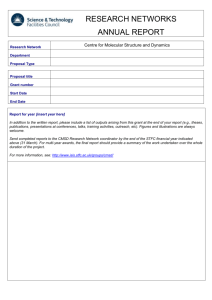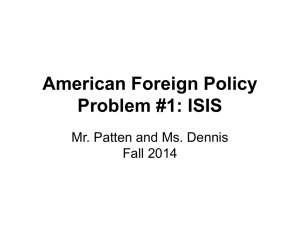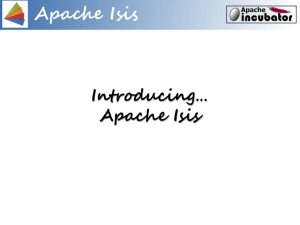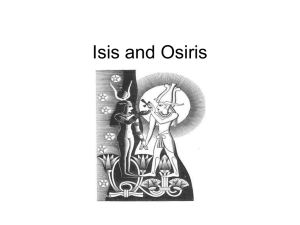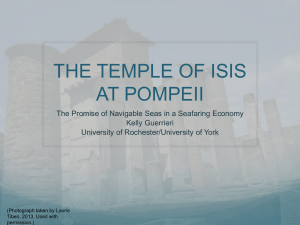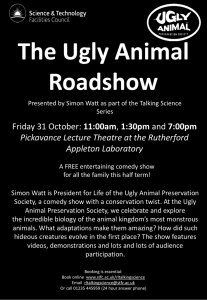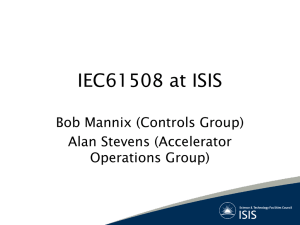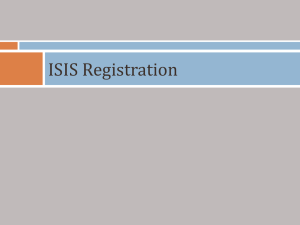Capturing data Provenance for Science
advertisement
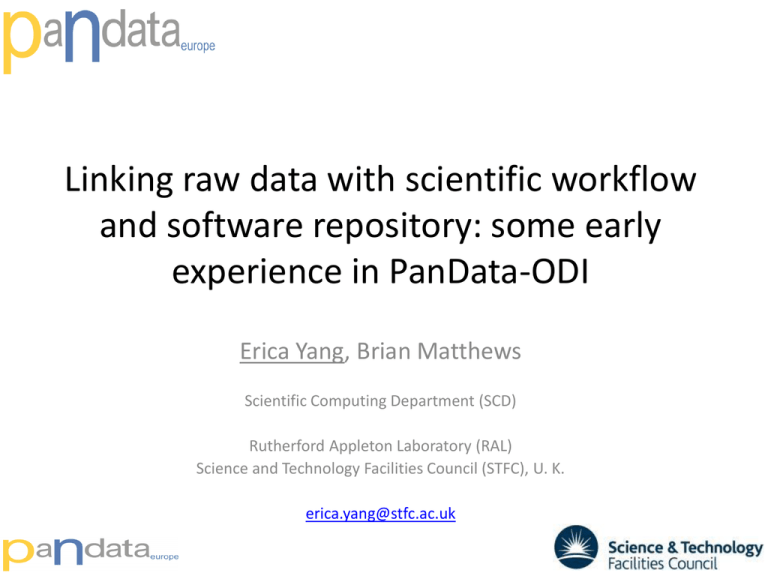
Linking raw data with scientific workflow and software repository: some early experience in PanData-ODI Erica Yang, Brian Matthews Scientific Computing Department (SCD) Rutherford Appleton Laboratory (RAL) Science and Technology Facilities Council (STFC), U. K. erica.yang@stfc.ac.uk BACKGROUND STFC Rutherford Appleton Laboratory STFC RAL: CLF, Diamond, ISIS, SCD What we do Scientific Computing Department ... Scientific Experiments and Communities (e.g. LHC, EGI, NGS, SCARF, NSCCS, CCP4, CCPi, Computational Sciences) Facility Sciences (e.g. ISIS, CLF, Diamond, PanData Community) Institutional repository, metadata catalogue, semantic web, DOIs, visualisation facilities, supporting data processing pipelines Software development (tools and technologies) Data management infrastructure, systems and software Application/user support Super Computer, HPC, storage, monitoring and archiving infrastructure, services and software Large scale compute clusters, GPU clusters, storage disk and robotic tape systems Communities Applications Technologies Services Infrastructure Hardware What we do Scientific Computing Department ... Scientific Experiments and Communities (e.g. LHC, EGI, NGS, SCARF, NSCCS, CCP4, CCPi, Computational Sciences) Facility Sciences (e.g. ISIS, CLF, Diamond, PanData Community) Institutional repository, metadata catalogue, semantic web, DOIs, visualisation facilities, supporting data processing pipelines Software development (tools and technologies) Data management infrastructure, systems and software Application/user support Super Computer, HPC, storage, monitoring and archiving infrastructure, services and software Large scale compute clusters, GPU clusters, storage disk and robotic tape systems I am a computer scientist ... I2S2, SRF, PanData-ODI, SCAPE, PinPoinT, TomoDM Communities Applications Technologies Services Infrastructure Hardware PANDATA-ODI PaN-data ODI– an Open Data Infrastructure for European Photon and Neutron laboratories Federated data catalogues supporting cross-facility, cross-discipline interaction at the scale of atoms and molecules Neutron diffraction X-ray diffraction High-quality structure refinement • Unification of data management policies • Shared protocols for exchange of user information • • Common scientific data formats • Data Provenance WP: Linking Data and Publications • Digital Preservation: supporting the long-term preservation of the research outputs Interoperation of data analysis software (Facility) Data Continuum Metadata Catalogue Publication Proposal Approval Data analysis Scheduling Experiment Data reduction Services on top of ICAT: DOI, TopCAT, Eclipse ICAT Explorer ... PanSoft Data Continuum Metadata Catalogue Publication Proposal Approval Data analysis Scheduling Experiment Well developed and supported Data reduction PanSoft • These are with users. • Traditionally, these, although very useful for data citation, reuse and sharing, are very difficult to capture! • Practices vary from individuals to individuals, and from institutions to institutions Prior Experience Raw data Derived data Resultant data Credits: Martin Dove, Erica Yang (Nov. 2009) Can be difficult to capture ... Credits: Alan Soper (Jan. 2010) Data Provenance: Case Studies (so far) 1. Description Automated SANS2D reduction and analysis Facility ISIS 2. Tomography reconstruction and Manchester Uni./DLS analysis 3. EXPRESS Services ISIS 4. Recording publications arising from proposal ISIS 5. DAWN + iSpyB DLS, ESRF Likely stages of continuum Experiment/Sample preparation Raw data collection Data reduction Data Analysis Raw data Reconstructed data Analysed data Experiment preparation Raw data collection Data Analysis to standard final data product Proposal system Raw Data collection Publication recording Experiment preparation Data analysis steps These case studies have given us unique insights into today’s facilities ... Looking for more case studies ... TODAY’S FACILITIES – FACTS Diamond and ISIS (the story so far ...) • Diamond: – ~ 290TB and 120 million files [1] – In SCD data archive – Largest file: ~120GB – Tomography beamlines [3] • ISIS [2]: – ~16TB and 11 million files – In ISIS data archive & SCD data archive (on going) – Largest file: ~16GB – the WISH instrument Diamond Tomography • • • • • Up to 120 GBs/file every 30 minutes 6,000 TIFF images/file Up to 200 GBs/hr ~5 TBs/day 1-3 days/experiment How many images are there for each experiment? ISIS • Peak data copy rate (off instrument) 100MB/S – Expecting to reach 500MB-1GB/S (but not soon). • Expect to grow to 10TB/cycle in 3-5 years • Become interested in centrally hosted services (WISH) WHAT DOES IT MEAN? It means ... • Due to the volume, it is not cost effective to transfer the (raw + reconstructed) data back to the home institutions or elsewhere to process – The network bandwidth to universities mean that it will take a long time to transfer ... – So, users have to physically take data back home on storage drive ... • It is impossible for users to do the reconstruction or analysis on their own computer/laptop. – How much RAM do you have on your laptop? And how big is the file from WISH? The Mantid story ... • It is expensive to re-do the analysis back to the home institutions because of – Lack of hardware resources – Lack of metadata (a large number of files often mean that there is not much useful metadata) – Lack of expertise (e.g. parallel processing, GPU programming) – (Assuming software is open source ...) • Facilities become interested, again, in centralised computing services, right next to the data – The ISIS WISH story ... – Diamond GPU cluster vs. SCD GPU cluster (directly linked to the data archive) Users now ask for remote services • Users are interested in remote data analysis services – “... Of course this would mean a step change in the facilities provided and the time users spend at the facility. ... ” – In response, we are developing: “TomoDM” ... • Then, what benefits can remote services bring? – Systematic recording of data continuum, thus allowing the recording of scientific workflows, software, and data provenance (the first four categories data as defined in the “Living Publication” [4]) – Drive data processing (reduction & analysis) with data provenance – It is not only possible to create bi-directional links between raw data and publications, it is also possible to systematically create pair-wise bi-directional links between raw, derived, resultant data and publications. TWO EXAMPLES SRF – Automated Data Processing Pipeline for ISIS OpenGenie Script SampleTracks Samples, Experiment setup Raw data Data Acquisition Raw data Reduced data Data Reduction Reduced data ICAT Data Catalogue Blog Posts in LabTrove Model Fitting Analysed data Links between metadata and files Raw data Metadata nexus format pointer Actual data in blobs One HDF5 (e.g. 2MB) – NeXus format One HDF5 (e.g. 120GB) DOI Service (between raw and processed data) Nexus – raw pointer Reconstructed/ Processed data Metadata nexus format pointer Actual data in blobs One HDF5 (e.g. 2MB) One HDF5 (e.g. 120GB) But ... • If we can capture all types of data – – – – – – Samples Raw data Reduced data Analysed data Software Data provenance (i.e. Relationships between datasets) • Facilities operators do not normally – Perform validation and fixity checking of data files (volume vs. cost) – Actually MUCH cheaper to simply back up all images without regard for quality, relevance or even duplication, than it is to build an infrastructure for automatically analyzing millions of image files to determine which are “worth keeping”. [1] – But lifetime of data on tape vs. Lifetime of tape • Will DOIs good enough for data citation? STFC EXPERIENCE OF USING DATACITE DOIS STFC DOI landing page Behind the landing page Citation Issues • At what granularity should data be made citable? – If single datasets are given identifiers, what about collections of datasets, or subsets of data? – What are we citing? Datasets or an aggregation of datasets • STFC link DOI to experiments on large facilities which contain many data files • Other organisations DOI usage policies use different granularities. • Can there be a common, or discipline common DOI usage policy for data? • Citation of different types of object: software, processes, workflows ... • Private vs. Public datasets/DOIs Summary • Infrastructure services – – – – – Compute Storage Archiving + preservation (validation, integrity) Remote data processing DOIs • It is already happening – DLS is already collecting processed data (e.g. iSpyB) – But, interesting issues remind to be resolved when lots of data become available ... Acknowledgements Project (s) Institution(s) People PanData-ODI (case study) Diamond, U.K. Mark Basham, Kaz Wanelik PanData-ODI: (case study) Manchester University, U.K. Harwell Research Complex, RAL Diamond, U.K. Prof. Philip Withers, Prof. Peter Lee SCAPE, SRF, PanData-ODI Scientific Computing Department, STFC David Corney, Shaun De Witt, Chris Kruk, Michael, Wilson I2S2, SRF Chemistry, Southampton University, UK Prof. Jeremy Frey, Dr. Simon Coles I2S2 Cambridge University, UK Prof. Martin Dove I2S2, PanData-ODI, SRF, SCAPE ISIS, STFC Tom Griffin, Chris Morton-Smith, Alan Soper, Silvia Imberti, Cameron Neylon, Ann Terry, Matt Tucker I2S2, SRF are funded by JISC, UK PanData-ODI, SCAPE are funded by EC References 1. Colin Nave (Diamond), “Survey of Future Data Archiving Policies for Macromolecular Crystallography at Synchrotrons”, distributed via “dddwg-bounces@iucr.org”, July 2012. 2. Chris Morton-Smith (ISIS), “ISIS Data rates and sizes – up to March 2012”, May 2012. 3. Mark Basham (Diamond), “HDF5 Parallel Reading and Tomography Processing at DLS”, PanData-ODI DESY meeting, Hamburg, Germany, Feb. 2012. 4. John R Helliwell, Thomas C. Terwilliger, Brian McMahon, “The Living Publication”, April 2012. Questions Backup Backup
